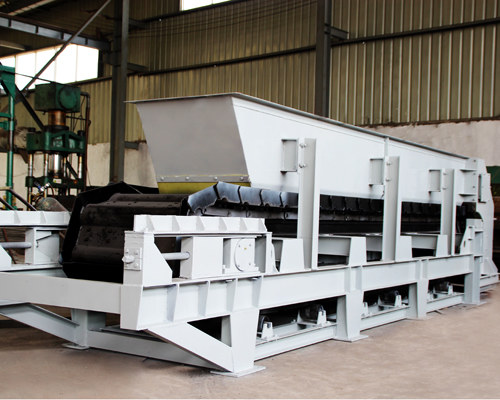The reason of
apron feeder chain plate sticking
The phenomenon of sticky chain plate will occur when using the apron feeder for a while. Because the chainplate is often subject to the impact of ore. It is usually equipped with transverse reinforcing bars to reinforce the chainplate. The wet powder material adheres to the root of the reinforcing bar. When the chainplate enters the return section from the bearing section, the sticky material will fall from at times. After a long time, the material pile will form on the ground, which not only pollutes the environment but also is not conducive to the safe operation of the equipment. The phenomenon of sticky material accumulation only occurs in the head of the feeder (within 1 m length from the head drum), and there is no accumulation in the tail. About half a month, the accumulation needs to be cleaned, which brings some workload to the maintenance personnel.
The reasons are mainly as follows:
1) the actual moisture content of the incoming material and the information provided by the technical agreement come in and out, and the moisture content is relatively large, which leads to the wet adhesion of the material and easy absorption of the equipment.
2) In order to avoid producing a large amount of dust and protect the working environment, spray dust suppression devices are set at the upper and lower outlet of the discharging hopper due to the large material drop difference during discharging by the dump truck. When the conveying system is in operation, a large amount of water mist is sprayed out by the spray dust suppression device, which increases the moisture on the surface of materials and increases the absorption of materials.
3) the chainplate is equipped with transverse reinforcing bars, which causes a bulge on the surface of the chainplate, affecting the smoothness of the surface and increasing the possibility of material adsorption.
4) for sticky materials, it is usually necessary to set a cleaning device at the bottom of the
apron feeder to reclamation.
The solution
1) lifting the apron feeder as a whole, installing a cleaning chain on the lower part to cut off part of the protective cover (trough) on the tail of the feeder at an appropriate position, and cutting a material through the mouth with the same shape as the section of the protective cover of the feeder near the side of the discharging funnel. Then lift the feeder 959 mm vertically, add another leg with a height of 959 mm to each lower leg of the feeder, and connect it with the original leg and the foundation with bolts respectively. Then, the upper part of the belt conveyor is cut off and replaced with a specially made non-standard connection section, with a height of about 1 310 mm. Finally, the lower part of the apron feeder is equipped with a scraper conveyor to clean the material.
2) adding roller brush sweeper to the head of an apron feeder. A square hole is cut on the two faces perpendicular to the head drum under the hopper of the feeder head. Pass the roller brush sweeper through the square hole and fix it on the head funnel along the direction of the roller. The roller brush sweeper has a drive, which is connected with the feeder. When the apron feeder running, the roller brush also turns in reverse to play the role of cleaning. In this scheme, the workload of equipment transformation is very small, the transformation cycle is short, hardly affecting the production and operation of the port, and the transformation cost is very low, which the owner readily accepts. After the transformation, the cleaning effect of the roller brush was very good for a while. However, due to the soft texture and poor wear resistance of the brush wire, the brush wire of roller brush was quickly worn out after the apron feeder ran for a while
3) improve the smoothness of the bearing surface of the chain plate. As the adhesion point of the
apron feeder is mainly located at the root of the transverse stiffeners of the chain plate, the smooth transition between the stiffeners and the surface of the chain plate can reduce the bonding of materials.Therefore, steel bars 36 mm wide and as long as chain plate reinforcing bars are made from 10 mm thick steel plates.The steel bar is welded to the chain plate stiffener at an Angle of 30°to fill in the included Angle formed between the stiffener and the chain plate surface.





